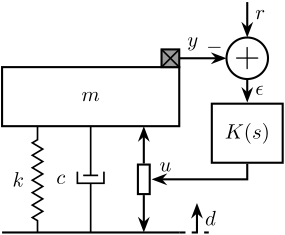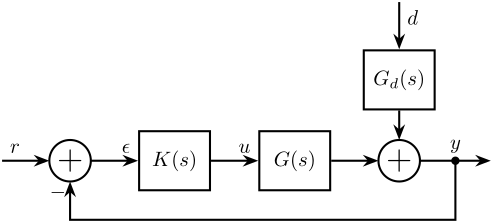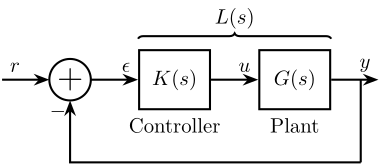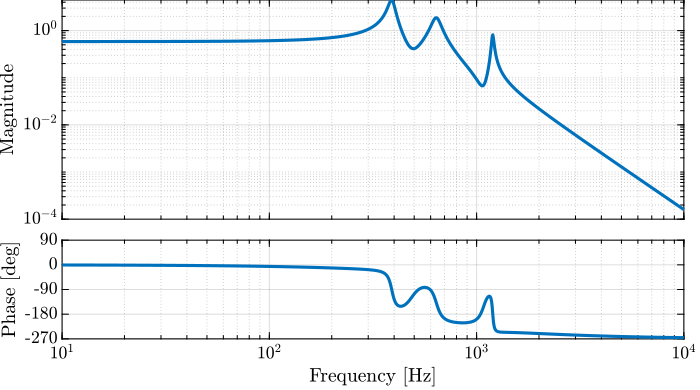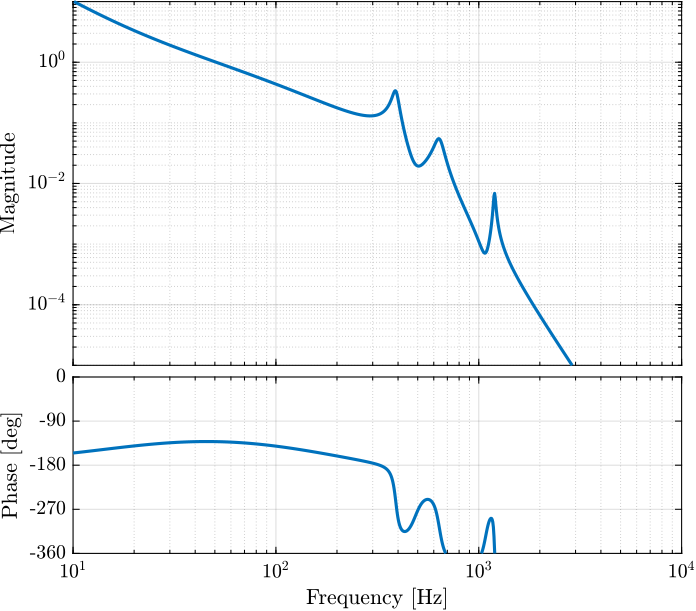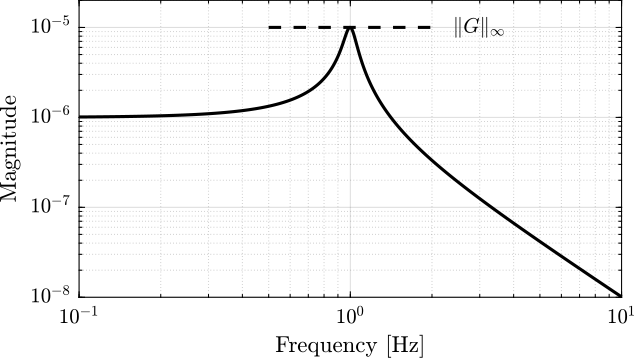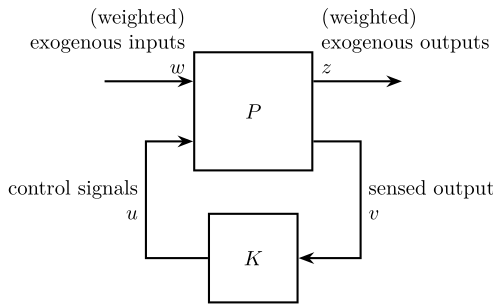27 KiB
Robust Control - $\mathcal{H}_\infty$ Synthesis
- Introduction
- Introduction to the Control Methodology - Model Based Control
- Classical Open Loop Shaping
- The $\mathcal{H}_\infty$ Norm
- $\mathcal{H}_\infty$ Synthesis
- The Generalized Plant
- Problem Formulation
- Classical feedback control and closed loop transfer functions
- From a Classical Feedback Architecture to a Generalized Plant
- Modern Interpretation of the Control Specifications
- Resources
Introduction ignore
Introduction to the Control Methodology - Model Based Control
Control Methodology
The typical methodology when applying Model Based Control to a plant is schematically shown in Figure fig:control-procedure. It consists of three steps:
- Identification or modeling: $\Longrightarrow$ mathematical model
-
Translate the specifications into mathematical criteria:
- Specifications: Response Time, Noise Rejection, Maximum input amplitude, Robustness, …
- Mathematical Criteria: Cost Function, Shape of TF
- Synthesis: research of $K$ that satisfies the specifications for the model of the system
\begin{tikzpicture}
\node[addb={+}{}{}{}{-}] (addsub) at (0, 0){};
\node[block, right=1.5 of addsub] (controller) {Controller};
\node[block, right=1.5 of controller] (plant) {Plant};
\node[block, above=1 of controller] (controller_design) {Synthesis};
\node[block, above=1 of plant] (model_plant) {Model};
\draw[<-] (addsub.west) -- ++(-1, 0) node[above right]{$r$};
\draw[->] (addsub) -- (controller.west) node[above left]{$\epsilon$};
\draw[->] (controller) -- (plant.west) node[above left]{$u$};
\draw[->] (plant.east) -- ++(1, 0) node[above left]{$y$};
\draw[] ($(plant.east) + (0.5, 0)$) -- ++(0, -1);
\draw[->] ($(plant.east) + (0.5, -1)$) -| (addsub.south);
\draw[->, dashed] (plant) -- node[midway, right, labelc, solid]{1} (model_plant);
\draw[->, dashed] (controller_design) --node[midway, right, labelc, solid]{3} (controller);
\draw[->, dashed] (model_plant) -- (controller_design);
\draw[<-, dashed] (controller_design.west) -- node[midway, above, labelc, solid]{2} ++(-1, 0) node[left, style={align=center}]{Specifications};
\end{tikzpicture}In this document, we will mainly focus on steps 2 and 3.
Some Background: From Classical Control to Robust Control
Classical Control (1930)
-
Tools:
- TF (input-output)
- Nyquist, Bode, Black, \ldots
- P-PI-PID, Phase lead-lag, \ldots
-
Advantages:
- Stability
- Performances
- Robustness
-
Disadvantages:
- Manual Method
- Only SISO
Modern Control (1960)
-
Tools:
- State Space
- Optimal Command
- LQR, LQG
-
Advantages:
- Automatic Synthesis
- MIMO
- Optimisation problem
-
Disadvantages:
- Robustness
- Rejection of Perturbations
Robust Control (1980)
-
Tools:
- Disk Margin
- Systems and Signals norms ($\mathcal{H}_\infty$ and $\mathcal{H}_2$ norms)
- Closed Loop Transfer Functions
- Loop Shaping
-
Advantages:
- Stability
- Performances
- Robustness
- Automatic Synthesis
- MIMO
- Optimization Problem
-
Disadvantages:
- Requires the knowledge of specific tools
- Need a reasonably good model of the system
Example System
Let's consider the test-system shown in Figure fig:mech_sys_1dof_inertial_contr. The notations used are listed in Table tab:example_notations.
\begin{tikzpicture}
% Parameters
\def\massw{3}
\def\massh{1}
\def\spaceh{1.8}
% Ground
\draw[] (-0.5*\massw, 0) -- (0.5*\massw, 0);
% Mass
\draw[fill=white] (-0.5*\massw, \spaceh) rectangle (0.5*\massw, \spaceh+\massh) node[pos=0.5](m){$m$};
% Spring, Damper, and Actuator
\draw[spring] (-0.3*\massw, 0) -- (-0.3*\massw, \spaceh) node[midway, left=0.1]{$k$};
\draw[damper] ( 0, 0) -- ( 0, \spaceh) node[midway, left=0.3]{$c$};
\draw[actuator] ( 0.3*\massw, 0) -- (0.3*\massw, \spaceh) node[midway](F){};
% Displacements
\draw[dashed] (0.5*\massw, 0) -- ++(0.5, 0);
\draw[->] (0.6*\massw, 0) -- ++(0, 0.5) node[below right]{$d$};
% Inertial Sensor
\node[inertialsensor] (inertials) at (0.5*\massw, \spaceh+\massh){};
\node[addb={+}{-}{}{}{}, right=0.8 of inertials] (subf) {};
\node[block, below=0.4 of subf] (K){$K(s)$};
\draw[->] (inertials.east) node[above right]{$y$} -- (subf.west);
\draw[->] (subf.south) -- (K.north) node[above right]{$\epsilon$};
\draw[<-] (subf.north) -- ++(0, 0.6) node[below right]{$r$};
\draw[->] (K.south) |- (F.east) node[above right]{$u$};
\end{tikzpicture}| Notation | Description | Value | Unit |
|---|---|---|---|
| $m$ | Payload's mass to position / isolate | [kg] | |
| $k$ | Stiffness of the suspension system | [N/m] | |
| $c$ | Damping coefficient of the suspension system | [N/(m/s)] | |
| $y$ | Payload absolute displacement (measured by an inertial sensor) | [m] | |
| $d$ | Ground displacement, it acts as a disturbance | [m] | |
| $u$ | Actuator force | [N] | |
| $r$ | Wanted position of the mass (the reference) | [m] | |
| $\epsilon = r - y$ | Position error | [m] | |
| $K$ | Feedback controller | to be designed | [N/m] |
Derive the following open-loop transfer functions:
\begin{align} G(s) &= \frac{y}{u} \\ G_d(s) &= \frac{y}{d} \end{align}Hint: You can follow this generic procedure:
- List all applied forces ot the mass: Actuator force, Stiffness force (Hooke's law), …
- Apply the Newton's Second Law on the payload \[ m \ddot{y} = \Sigma F \]
- Transform the differential equations into the Laplace domain: \[ \frac{d\ \cdot}{dt} \Leftrightarrow \cdot \times s \]
- Write $y(s)$ as a function of $u(s)$ and $w(s)$
Having obtained $G(s)$ and $G_d(s)$, we can transform the system shown in Figure fig:mech_sys_1dof_inertial_contr into a classical feedback form as shown in Figure fig:open_loop_shaping.
\begin{tikzpicture}
\node[addb={+}{}{}{}{-}] (addfb) at (0, 0){};
\node[block, right=0.8 of addfb] (K){$K(s)$};
\node[block, right=0.8 of K] (G){$G(s)$};
\node[addb={+}{}{}{}{}, right=0.8 of G] (addd){};
\node[block, above=0.5 of addd] (Gd){$G_d(s)$};
\draw[<-] (addfb.west) -- ++(-0.8, 0) node[above right]{$r$};
\draw[->] (addfb.east) -- (K.west) node[above left]{$\epsilon$};
\draw[->] (K.east) -- (G.west) node[above left]{$u$};
\draw[->] (G.east) -- (addd.west);
\draw[<-] (Gd.north) -- ++(0, 0.8) node[below right]{$d$};
\draw[->] (Gd.south) -- (addd.north);
\draw[->] (addd.east) -- ++(1.2, 0);
\draw[->] ($(addd.east) + (0.6, 0)$) node[branch]{} node[above]{$y$} -- ++(0, -1.0) -| (addfb.south);
\end{tikzpicture} k = 1e6; % Stiffness [N/m]
c = 4e2; % Damping [N/(m/s)]
m = 16; % Mass [kg] G = 1/(m*s^2 + c*s + k);
Gd = (c*s + k)/(m*s^2 + c*s + k);Classical Open Loop Shaping
Introduction ot Open Loop Shaping
Usually, the controller $K(s)$ is designed such that the loop gain $L(s)$ has desirable shape. This technique is called Open Loop Shaping.
For instance example all the specifications can usually be explained in terms of the open loop gain.
\begin{tikzpicture}
\node[addb={+}{}{}{}{-}] (addsub) at (0, 0){};
\node[block, right=0.8 of addsub] (K) {$K(s)$};
\node[below] at (K.south) {Controller};
\node[block, right=0.8 of K] (G) {$G(s)$};
\node[below] at (G.south) {Plant};
\draw[<-] (addsub.west) -- ++(-0.8, 0) node[above right]{$r$};
\draw[->] (addsub) -- (K.west) node[above left]{$\epsilon$};
\draw[->] (K.east) -- (G.west) node[above left]{$u$};
\draw[->] (G.east) -- ++(0.8, 0) node[above left]{$y$};
\draw[] ($(G.east) + (0.5, 0)$) -- ++(0, -1.4);
\draw[->] ($(G.east) + (0.5, -1.4)$) -| (addsub.south);
\draw [decoration={brace, raise=5pt}, decorate] (K.north west) -- node[above=6pt]{$L(s)$} (G.north east);
\end{tikzpicture}This is usually done manually has the loop gain $L(s)$ depends linearly of $K(s)$:
\begin{equation} L(s) = G(s) K(s) \end{equation}- where $L(s)$ is called the Loop Gain Transfer Function
$K(s)$ then consists of a combination of leads, lags, notches, etc. such that its product with $G(s)$ has wanted shape.
Example of Open Loop Shaping
k = 1e-6;
m = 10;
c = 10;
G =Specifications:
- Performance: Bandwidth of approximately 50Hz
- Noise Attenuation: Roll-off of -40dB/decade past 250Hz
- Robustness: Gain margin > 5dB and Phase margin > 40 deg
Using SISOTOOL, design a controller that fulfill the specifications.
sisotool(G)In order to have the wanted Roll-off, two integrators are used, a lead is also added to have sufficient phase margin.
The obtained controller is shown below, and the bode plot of the Loop Gain is shown in Figure fig:loop_gain_manual_afm.
K = 6e4 * ... % Gain
1/(s^2) * ... % Double Integrator
(1 + s/111)/(1 + s/888); % LeadAnd we can verify that we have the wanted stability margins:
[Gm, Pm, ~, Wc] = margin(G*K)| Value | |
|---|---|
| Gain Margin [dB] | 7.2 |
| Phase Margin [deg] | 48.1 |
| Crossover [Hz] | 50.7 |
$\mathcal{H}_\infty$ Loop Shaping Synthesis
The Open Loop Shaping synthesis can be performed using the $\mathcal{H}_\infty$ Synthesis.
Even though we will not go into details, we will provide one example.
Using Matlab, the $\mathcal{H}_\infty$ synthesis of a controller based on the wanted open loop shape can be performed using the loopsyn command:
K = loopsyn(G, Gd);where:
Gis the (LTI) plantGdis the wanted loop shapeKis the synthesize controller
Matlab documentation of loopsyn (link).
Example of the $\mathcal{H}_\infty$ Loop Shaping Synthesis
Let's re-use the previous plant.
Translate the specification into the wanted shape of the open loop gain.
G = tf(16,[1 0.16 16]);
Gd = 3.7e4*1/s*(1 + s/2/pi/20)/(1 + s/2/pi/220)*1/(s + s/2/pi/500); [K,CL,GAM,INFO] = loopsyn(G, Gd); bodeFig({K})The $\mathcal{H}_\infty$ Norm
The $\mathcal{H}_\infty$ norm is defined as the peak of the maximum singular value of the frequency response
\begin{equation} \|G(s)\|_\infty = \max_\omega \bar{\sigma}\big( G(j\omega) \big) \end{equation}For a SISO system $G(s)$, it is simply the peak value of $|G(j\omega)|$ as a function of frequency:
\begin{equation} \|G(s)\|_\infty = \max_{\omega} |G(j\omega)| \label{eq:hinf_norm_siso} \end{equation}Let's define a plant dynamics:
w0 = 2*pi; k = 1e6; xi = 0.04;
G = 1/k/(s^2/w0^2 + 2*xi*s/w0 + 1);
And compute its $\mathcal{H}_\infty$ norm using the hinfnorm function:
hinfnorm(G)1.0013e-05
The magnitude $|G(j\omega)|$ of the plant $G(s)$ as a function of frequency is shown in Figure fig:hinfinity_norm_siso_bode. The maximum value of the magnitude over all frequencies does correspond to the $\mathcal{H}_\infty$ norm of $G(s)$ as Equation eqref:eq:hinf_norm_siso implies.
$\mathcal{H}_\infty$ Synthesis
Optimization problem: $\mathcal{H}_\infty$ synthesis is a method that uses an algorithm (LMI optimization, Riccati equation) to find a controller of the same order as the system so that the $\mathcal{H}_\infty$ norms of defined transfer functions are minimized.
Engineer work:
- Write the problem as standard $\mathcal{H}_\infty$ problem
- Translate the specifications as $\mathcal{H}_\infty$ norms
- Make the synthesis and analyze the obtain controller
- Reduce the order of the controller for implementation
Many ways to use the $\mathcal{H}_\infty$ Synthesis:
- Traditional $\mathcal{H}_\infty$ Synthesis
- Mixed Sensitivity Loop Shaping
- Fixed-Structure $\mathcal{H}_\infty$ Synthesis
- Signal Based $\mathcal{H}_\infty$ Synthesis
The Generalized Plant
\begin{tikzpicture}
\node[block={2.0cm}{2.0cm}] (P) {$P$};
\node[above] at (P.north) {Generalized Plant};
% Input and outputs coordinates
\coordinate[] (inputw) at ($(P.south west)!0.75!(P.north west)$);
\coordinate[] (inputu) at ($(P.south west)!0.25!(P.north west)$);
\coordinate[] (outputz) at ($(P.south east)!0.75!(P.north east)$);
\coordinate[] (outputv) at ($(P.south east)!0.25!(P.north east)$);
% Connections and labels
\draw[<-] (inputw) -- ++(-0.8, 0) node[above right]{$w$};
\draw[<-] (inputu) -- ++(-0.8, 0) node[above right]{$u$};
\draw[->] (outputz) -- ++(0.8, 0) node[above left]{$z$};
\draw[->] (outputv) -- ++(0.8, 0) node[above left]{$v$};
\end{tikzpicture}| Notation | Meaning |
|---|---|
| $P$ | Generalized plant model |
| $w$ | Exogenous inputs: commands, disturbances, noise |
| $z$ | Exogenous outputs: signals to be minimized |
| $v$ | Controller inputs: measurements |
| $u$ | Control signals |
Problem Formulation
The $\mathcal{H}_\infty$ Synthesis objective is to find all stabilizing controllers $K$ which minimize
\begin{equation} \| F_l(P, K) \|_\infty = \max_{\omega} \overline{\sigma} \big( F_l(P, K)(j\omega) \big) \end{equation} \begin{tikzpicture}
% Blocs
\node[block={2.0cm}{2.0cm}] (P) {$P$};
\node[block={1.5cm}{1.5cm}, below=0.7 of P] (K) {$K$};
% Input and outputs coordinates
\coordinate[] (inputw) at ($(P.south west)!0.75!(P.north west)$);
\coordinate[] (inputu) at ($(P.south west)!0.25!(P.north west)$);
\coordinate[] (outputz) at ($(P.south east)!0.75!(P.north east)$);
\coordinate[] (outputv) at ($(P.south east)!0.25!(P.north east)$);
% Connections and labels
\draw[<-] (inputw) node[above left, align=right]{(weighted)\\exogenous inputs\\$w$} -- ++(-1.5, 0);
\draw[<-] (inputu) -- ++(-0.8, 0) |- node[left, near start, align=right]{control signals\\$u$} (K.west);
\draw[->] (outputz) node[above right, align=left]{(weighted)\\exogenous outputs\\$z$} -- ++(1.5, 0);
\draw[->] (outputv) -- ++(0.8, 0) |- node[right, near start, align=left]{sensed output\\$v$} (K.east);
\end{tikzpicture}Classical feedback control and closed loop transfer functions
\begin{tikzpicture}
\node[addb={+}{}{}{}{-}] (addfb) at (0, 0){};
\node[block, right=0.8 of addfb] (K){$K(s)$};
\node[addb={+}{}{}{}{}, right=0.8 of K] (addu){};
\node[block, right=0.8 of addu] (G){$G(s)$};
\draw[<-] (addfb.west) -- ++(-0.8, 0) node[above right]{$r$};
\draw[->] (addfb.east) -- (K.west) node[above left]{$\epsilon$};
\draw[->] (K.east) -- (addu.west) node[above left]{$u$};
\draw[->] (addu.east) -- (G.west);
\draw[<-] (addu.north) -- ++(0, 0.8) node[below right]{$d$};
\draw[->] (G.east) -- ++(1.2, 0);
\draw[->] ($(G.east) + (0.6, 0)$) node[branch]{} node[above]{$y$} -- ++(0, -0.8) -| (addfb.south);
\end{tikzpicture}| Notation | Meaning |
|---|---|
| $G$ | Plant model |
| $K$ | Controller |
| $r$ | Reference inputs |
| $y$ | Plant outputs |
| $u$ | Control signals |
| $d$ | Input Disturbance |
| $\epsilon$ | Tracking Error |
From a Classical Feedback Architecture to a Generalized Plant
The procedure is:
- define signals of the generalized plant
- Remove $K$ and rearrange the inputs and outputs
\begin{tikzpicture}
\node[addb={+}{}{}{}{-}] (addfb) at (0, 0){};
\node[block, right=0.8 of addfb] (K){$K(s)$};
\node[block, right=0.8 of K] (G){$G(s)$};
\draw[<-] (addfb.west) -- ++(-0.8, 0) node[above right]{$r$};
\draw[->] (addfb.east) -- (K.west) node[above left]{$\epsilon$};
\draw[->] (K.east) -- (G.west) node[above left]{$u$};
\draw[->] (G.east) -- ++(1.2, 0);
\draw[->] ($(G.east) + (0.6, 0)$) node[branch]{} node[above]{$y$} -- ++(0, -0.8) -| (addfb.south);
\end{tikzpicture} \begin{tikzpicture}
\node[block] (G) {$G(s)$};
\node[addb={+}{-}{}{}{}, right=0.6 of G] (addw) {};
\coordinate[above right=0.6 and 1.4 of addw] (u);
\coordinate[above=0.6 of u] (epsilon);
\coordinate[] (w) at ($(epsilon-|G.west)+(-1.4, 0)$);
\node[block, below left=0.8 and 0 of addw] (K) {$K(s)$};
% Connections
\draw[->] (G.east) -- (addw.west);
\draw[->] ($(addw.east)+(0.4, 0)$)node[branch]{} |- (epsilon) node[above left](z1){$\epsilon$};
\draw[->] ($(G.west)+(-0.4, 0)$)node[branch](start){} |- (u) node[above left](z2){$u$};
\draw[->] (addw.east) -- (addw-|z1) |- node[near start, right]{$v$} (K.east);
\draw[->] (K.west) -| node[near end, left]{$u$} ($(G-|w)+(0.4, 0)$) -- (G.west);
\draw[->] (w) node[above]{$w = r$} -| (addw.north);
\draw [decoration={brace, raise=5pt}, decorate] (z1.north east) -- node[right=6pt]{$z$} (z2.south east);
\begin{scope}[on background layer]
\node[fit={(G.south-|start.west) ($(z1.north west)+(-0.4, 0)$)}, inner sep=6pt, draw, dashed, fill=black!20!white] (P) {};
\node[below right] at (P.north west) {Generalized Plant $P(s)$};
\end{scope}
\end{tikzpicture}Let's find the Generalized plant of corresponding to the tracking control architecture shown in Figure fig:classical_feedback_tracking

First, define the signals of the generalized plant:
- Exogenous inputs: $w = r$
- Signals to be minimized: $z_1 = \epsilon$, $z_2 = u$
- Control signals: $v = y$
- Control inputs: $u$
Then, Remove $K$ and rearrange the inputs and outputs. We obtain the generalized plant shown in Figure fig:mixed_sensitivity_ref_tracking.
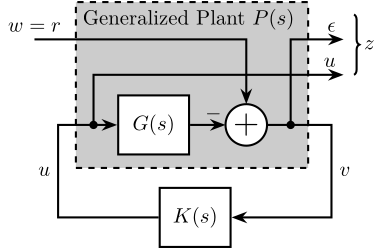
Using Matlab, the generalized plant can be defined as follows:
P = [1 -G;
0 1;
1 -G]Modern Interpretation of the Control Specifications
Introduction
-
Reference tracking Overshoot, Static error, Setling time
- $S(s) = T_{r \rightarrow \epsilon}$
-
Disturbances rejection
- $G(s) S(s) = T_{d \rightarrow \epsilon}$
-
Measurement noise filtering
- $T(s) = T_{n \rightarrow \epsilon}$
-
Small command amplitude
- $K(s) S(s) = T_{r \rightarrow u}$
-
Stability
- $S(s)$, $T(s)$, $K(s)S(s)$, $G(s)S(s)$
- Robustness to plant uncertainty (stability margins)
- Controller implementation
**
Resources
yt:?listType=playlist&list=PLn8PRpmsu08qFLMfgTEzR8DxOPE7fBiin
yt:?listType=playlist&list=PLsjPUqcL7ZIFHCObUU_9xPUImZ203gB4o

